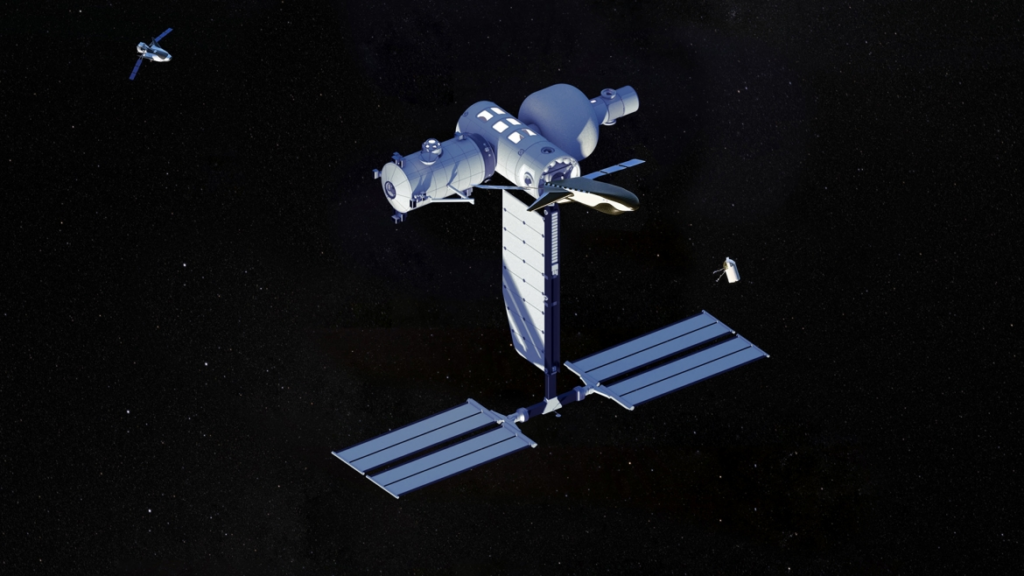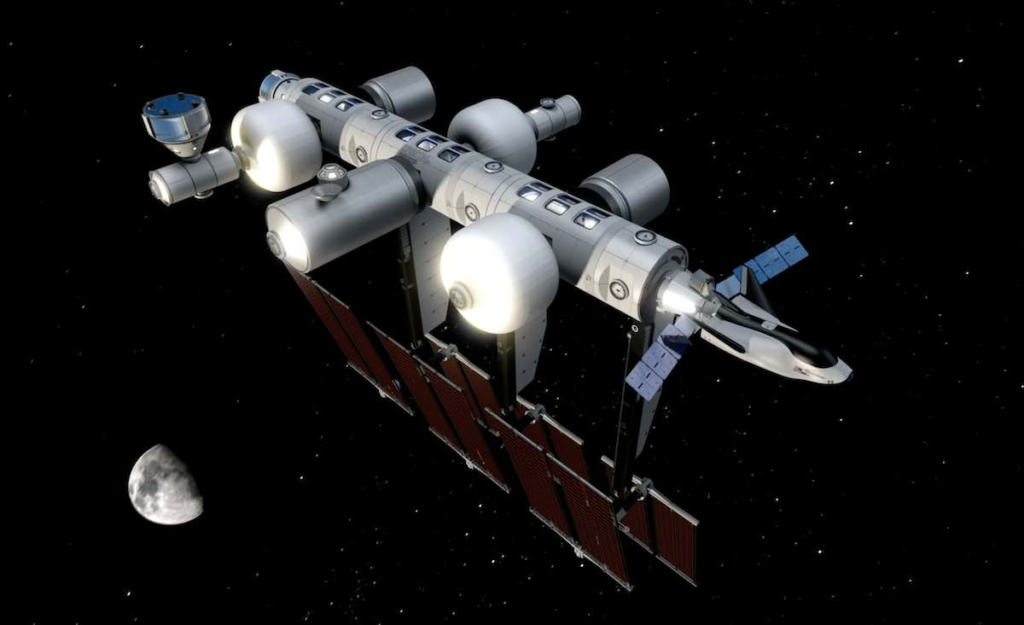
Orbital Reef Is One Step Closer To Reality
Each and everyday space is becoming more accessible. While this has mainly been in the form of launch vehicle development, companies are now working towards commercial space stations. One of the most ambitious projects is named Orbital Reef and has a few big contributors including Sierra Space, Blue Origin, Boeing, and more.
In just the last few days this project made some significant progress with the completion of the space station’s system definition review with NASA. The SDR is an important program milestone to establish the functional baseline for Orbital Reef. With this complete, the station moves on to its next hurdle which revolves around the design phase.
Orbital Reef is expected to be a commercially developed, owned and operated space station to be built in low-Earth orbit. While it still has a ways to go, this recent news is a good sign and means the list of companies involved can begin on some of the more significant tasks prior to launching segments. Here I will go more in-depth into the recent SDR with NASA, what’s next, future dates of the station, and more.
System Definition Review

Only a few days ago on the 22nd, Sierra Space tweeted saying, “Sierra Space and @blueorigin have successfully completed the Orbital Reef space station system definition review with NASA and advance to the design phase.” The System Definition Review or SDR is an important program milestone to establish the functional baseline for Orbital Reef, a commercially developed, owned and operated space station to be built in low-Earth orbit (LEO). It demonstrates to NASA that the space station design is feasible and achievable while validating that the Orbital Reef system is on-track to proceed into the design phase.
The Orbital Reef team, including Amazon Supply Chain, Amazon Web Services, Arizona State University, Boeing, Genesis Engineering Solutions, and Redwire Space, is maturing the design of its space station in partnership with NASA under the agency’s Commercial Low-Earth Orbit Development (CLDP) program. NASA awarded the agreement in December 2021 to shift NASA’s research and exploration activities in LEO to commercial space stations and help stimulate a growing space economy. For the last few months, the main progress related to this project has been with the individual companies. This update however is quite significant because it has to do with the station itself. While Sierra Space has been working on Dream Chaser and other important aspects, the station itself needs to be built in order for this idea to become a reality.
The recent SDR included an extensive review to ensure that the proposed Orbital Reef architecture is responsive to the functional and performance requirements; it examined the proposed system architecture and the flow-down to all functional elements of the Orbital Reef system. The successful SDR supported NASA’s decision to further develop the system architecture and design. Representatives from Blue Origin, Sierra Space, team members, and NASA participated in the review, conducted between mid-June and mid-July to allow in-depth review of documentation and feedback to the team. CEO of Sierra Space, Tom Vice pointed out, “We are on the doorstep of the most profound industrial revolution in human history. An industrial revolution marked by the transition from the last 60 years of space exploration to a future where humanity extends our factories and cities into space. It isn’t solely about tourism – it is about unlocking the next great discoveries using the microgravity factories that we will build just 250 miles above the Earth’s surface. “The microgravity factories and services provided by Orbital Reef have the potential to revolutionize every industry and become a major growth contributor to the U.S. and world economies.”
The companies involved are confident that Orbital Reef will open the next chapter of human space exploration and development by facilitating the growth of a vibrant ecosystem and business model for the future. Designed to open multiple new markets in space, Orbital Reef will provide anyone with the opportunity to establish their own address in orbit. This unique destination will offer research, industrial, international, and commercial customers the cost competitive end-to-end services they need including space transportation and logistics, space habitation, equipment accommodation, and operations including onboard crew. The station is expected to be operational by 2027. “This SDR moves Orbital Reef forward,” said Brent Sherwood, Senior Vice President of Advanced Development Programs at Blue Origin. “We are meeting the needs of both the commercial marketplace and NASA’s requirements. Orbital Reef will change the game for human space flight in Earth orbit.” All of this relies on the different companies involved and the progress that Orbital Reef can make. As of right now, there is still a lot of work to do before we see modules and people heading to LEO.
Orbital Reef’s Future

As partially mentioned prior, while this update is a step in the right direction, the real backbone of this ambitious idea relies on the different companies involved. The most recent update and completion of the SDR comes after reaching the SRR milestone earlier this year. Back on April 22nd, Orbital Reef completed its Systems Requirements Review (SRR) in just three months. The SRR was an important program milestone marking the baselining of the requirements for the mission and design of the station. Specifically, the review assessed Orbital Reef’s ability to meet safety and mission requirements and evaluated the technical readiness of the design, the concept of operations, the feasibility of project development plans, and planned verification activities. Representatives from Blue Origin, Sierra Space, team members, and NASA participated in the review, which was conducted virtually.
Orbital Reef will fly over most of humankind in a mid-inclination, 500-kilometer orbit. Different businesses are expected to have a great opportunity including scientific research, exploration system development, invention and manufacture of new and unique products, media and advertising, or exotic hospitality. The sales pitch for Orbital Reef includes world-class technical accommodations, futuristic space architecture with services and amenities that are inspiring, practical, and safe, and an open, scalable system architecture allow any nation, agency, culture, or customer to join. They provide an end-to-end service: transportation and logistics, leased space for any purpose, assistance with system hardware development, robotic and crew-tended operations and servicing, and habitation amenities. Experienced customers can simply link up their own modules through standard interfaces. Novice customers can get any level of help they need through the Reef Starter incubator. Station infrastructure – accommodations, utilities, berths, and vehicle ports – scales with market demand for unlimited growth. On the Orbital Reef business park, shared infrastructure supports the proprietary needs of diverse tenants and visitors. This business model – traditional on Earth but unprecedented in space – lowers barriers for all customers and promotes competitive development of space applications.
This gives a good example of what the companies involved are working towards and what they intend for Orbital Reef to become. While there are many different companies and groups involved in this project, Sierra Space and Blue Origin are the main ones. For many years now Sierra Space has been working to develop Dream Chaser which is expected to play a vital role in transportation between Earth and the station. Most recently the company has been working on Dream Chaser Tenacity which will be tested for the first time. Only a week ago on August 19th, the company highlighted the importance of this vehicle. Specifically, they pointed out that next chapter is being written today by Corneau and the entire Sierra Space team who are pouring their incredible skill, dedication, and plenty of sweat into preparing the first Dream Chaser spaceplane, appropriately named “Tenacity,” for its unshakable mission to make space available to all humankind.
Serving this purpose, the Sierra Space team is laser-focused on the mission of democratizing space. After all, venturing beyond Earth has been a consistent dream of humankind since the dawn of time. It’s only intensified since the first astronaut pioneers proved our dreams of space travel are no mere flights of fancy but attainable. Sierra Space President Dr. Janet Kavandi, explains: “Seeing the beautiful night sky, the Milky Way, you automatically dream of going up there. You can’t help but dream about that.” This all comes in addition to Blue Origin and its work on New Glenn, a necessary vehicle for the future of Orbital Reef.
Conclusion
Sierra Space, Blue Origin, and a host of other companies have been working hard to try and create a commercial space station. Only a few days ago Orbital Reef managed to complete its SDR which means it can move on to the design phase. We will have to wait and see how it progresses and the impact it has on the space industry.
